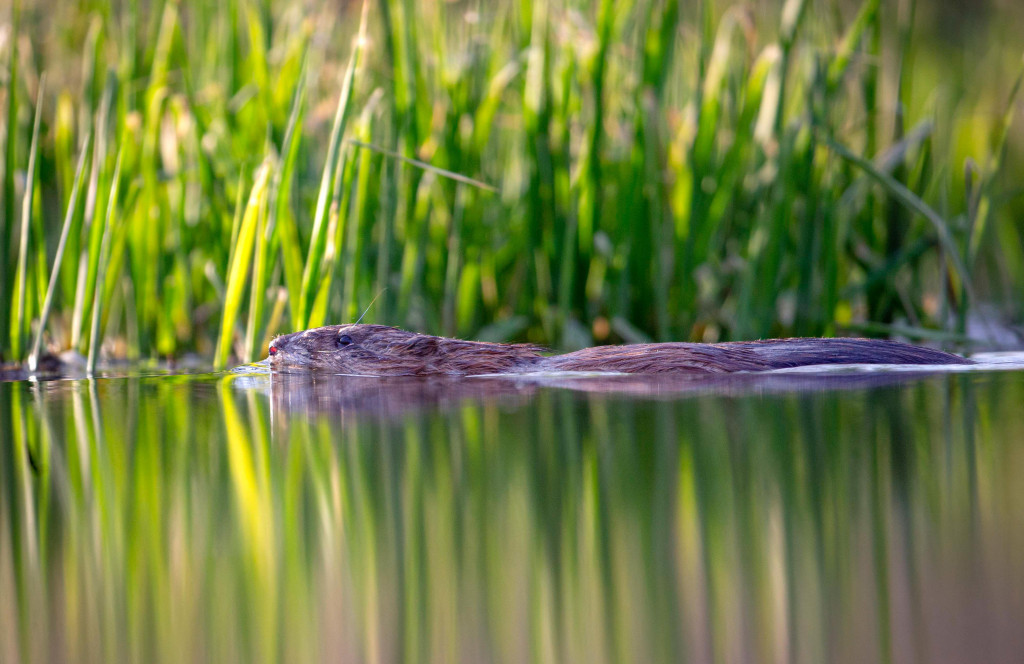
By Monica Macoubrie, Wildlife Education Specialist
Dwelling in the waterways and wetlands of Nebraska, beavers (Castor canadensis) are the architects of the Plains, shaping landscapes with their industrious dams and lodges. These remarkable rodents play a crucial role in the state’s ecosystem dynamics. From their adaptations in aquatic habitats to their significant influence on local biodiversity and water management, the presence of beavers tells the story of a species’ resilience among human neighbors and in a changing environment.
Nebraska’s Largest Rodents
Typically weighing 35 to 60 pounds with some individuals reaching up to 80 pounds, beavers have a stocky build and a broad, flat tail that can measure up to 15 inches long.
Their fur is dense and waterproof, consisting of a combination of short underfur and longer guard hairs, which range from deep brown to reddish-brown.
Their front legs are short and sturdy, equipped with sharp claws for digging and manipulating objects, while their hind legs are longer and webbed, which aids swimming.
Beavers possess large, orange-colored incisors — characteristic of most rodents — that continually grow throughout their lives, ideal for gnawing through trees, which allow them to construct their signature lodges and dams. Not only do all these adaptations allow beavers to thrive in their aquatic habitats, they also enable the species to play a critical role in shaping ecosystems through their engineering activities.
Lodge or Dam?
There are many misconceptions surrounding the structures that beavers create. Are they building a lodge or a dam? Is there a difference? Absolutely! And it’s a significant one.
Beaver lodges are the primary living quarters for beaver families and are marvels of natural engineering. Typically built in ponds or slow-moving water bodies, lodges provide shelter and protection from predators and harsh weather. The structures are constructed using branches, sticks, mud and aquatic vegetation. Beavers begin by anchoring larger branches into the mud before weaving smaller branches and sticks between them. Finally, they seal the structure with mud to insulate and waterproof it.
Lodges have multiple chambers inside, including a dry living area and underwater entrances. The underwater entrances offer beavers safe access that prevents predators from entering. These lodges can be quite large, sometimes reaching up to 10 feet in diameter and extending several feet above the surface of the water. The living quarters are lined with shredded wood and vegetation for added comfort and insulation, maintaining a relatively constant temperature even in freezing conditions.
In contrast, beaver dams are constructed to manipulate water levels, which creates the still, deep water environments that beavers prefer. Dams are built across streams and rivers using similar materials as lodges. The primary purpose of a dam is to slow down the flow of water, creating a pond or wetland upstream. This not only provides a safe habitat for the beavers but also benefits a variety of other wildlife by creating rich, diverse ecosystems.
The construction of a dam starts with the beavers anchoring large branches and logs in place, followed by filling gaps with smaller sticks, mud and stones to make the structure watertight. These dams can vary significantly in size, with some small enough to span a narrow stream and others extending over hundreds of feet.
Beavers as Keystone Species
A keystone species is a species that has a large impact on its ecosystem relative to its abundance or biomass. Keystone species can influence the availability of resources, modify habitat and regulate the populations of other species, often exerting a stabilizing effect on their ecological community.
Beavers in Nebraska serve as keystone species, playing a pivotal role in the health and biodiversity of local ecosystems. Their engineering skill is particularly significant, as they create and maintain habitats that support a multitude of species. By constructing dams across streams and rivers, beavers create ponds and wetlands that serve as critical habitats for fish, amphibians, waterfowl and numerous plant species. These wetlands act as natural filters, improving water quality by trapping sediment and pollutants, and they also regulate water flow, which can help mitigate downstream flooding and maintain water levels during dry periods.
Beyond their direct impact on water dynamics and habitat creation, beavers’ selective tree cutting promotes forest regeneration and creates diverse habitat structures that benefit a wide range of wildlife. Their activities increase the overall biodiversity of Nebraska’s landscapes, supporting species that depend on wetland habitats for breeding, feeding and shelter.
Additionally, the presence of beavers enhances ecological resilience by creating mosaic landscapes of different successional stages, which can buffer against environmental changes and disturbances.
Human and Beaver Interactions
Beavers and humans share a complex relationship characterized by both beneficial and challenging interactions. Beavers, as natural engineers, significantly impact their environments by creating wetlands that provide numerous ecological benefits. For humans, these benefits can translate into reduced flood risks, improved water resources and enhanced opportunities for wildlife observation and eco-tourism.
However, beaver activities also can lead to conflicts with human interests. Their dam-building can cause flooding of agricultural lands, roads and properties, leading to economic losses and necessitating costly management efforts. Additionally, beavers may fell trees that are valued for timber, landscaping or cultural purposes, further contributing to tensions.
In many regions, collaborative efforts between conservationists, landowners and government agencies aim to find sustainable solutions that allow humans and beavers to coexist. By understanding and managing the impacts of beaver activities, it is possible to harness their ecological benefits while mitigating their negative effects on human infrastructure and activities. For example, flow devices can control water levels around beaver dams, barriers can protect valuable trees, and sometimes, the relocation of beaver populations to less problematic areas is possible.
Beavers in Nebraska exemplify the intricate relationship between wildlife and human communities. By recognizing their ecological importance and implementing sustainable management practices, we can ensure that beavers continue to thrive and contribute to Nebraska’s natural landscapes for generations to come.
